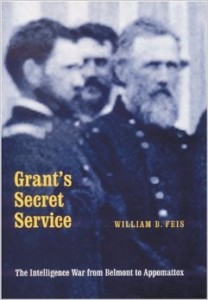
William B. Feis
4.0 out of 5 stars Well-Intentioned, Terrible Maps and No Timelines, May 28, 2002
I do not regret taking the time to read this book, and it is a well-intentioned worthy effort–however, given a new choice, I would probably go with the alternative, by an intelligence professional, “The Secret War for the Union: The Untold Story of Military Intelligence in the Civil War.”
I give the author, not an intelligence professional, high marks for the research, the story-telling, and the consistent themes. I give the editor and publisher low marks for the terrible maps (many seem to have lost their unit location markings and other key annotations) and the lack of tables showing “who knew what when…”
Three themes stayed with me as I put the book down:
1) A great deal can be accomplished in terms of intelligence with even a very small number of people–as few as 1-2 on staff, 3-5 behind the lines. We in America have substituted billions for technology and a cast of close to 100,000, for rather poor intelligence and counterintelligence.
2) Maps, especially “information maps,” are worth their weight in gold. I was reminded by this book that intelligence has in the past been an off-shoot of topographical engineering and map making, and do believe that we must restore the “hard-wired” connection between geospatial information and the “data” that our human, imagery, and signals professionals seek out.
3) Deserters, prisoners, and legal travelers are a gold mine of information and must, must, must be systematically exploited. No matter the degree to which they may offer up untruths and deceptions, the bottom line is that any commander who fails to plan for the systematic exploitation of these human resources, and to do so in a timely fashion, is derelict in their duty. As I recall, we do not yet have a proper table of organization or equipment in the U.S. force inventory for handling such individuals–the worst battalion, or the over-burdened military police, or some kludge collection of reservists, seems to end up being the solution each time. This dereliction is even more costly in “low intensity” environments.
I will not make too much of it, but I was especially pleased to see how much of Grant's intelligence came from enemy newspapers.
The author seeks to make much–perhaps too much–of how Grant did not allow himself to be immobilized by a lack of intelligence, substituting initiative when intelligence was lacking, but I for one don't buy it. What I see in the book is a substantive appreciation by the General Commanding of the role of intelligence, however poorly manned or funded, and that makes all the difference.




